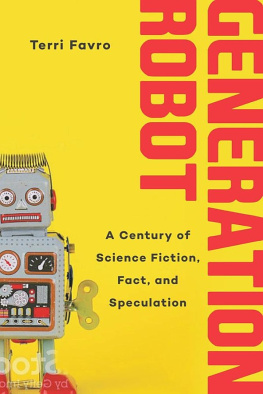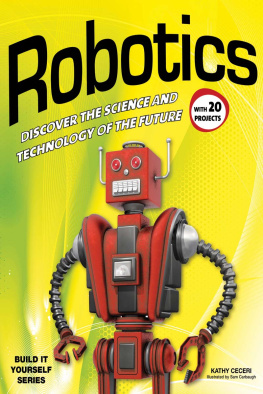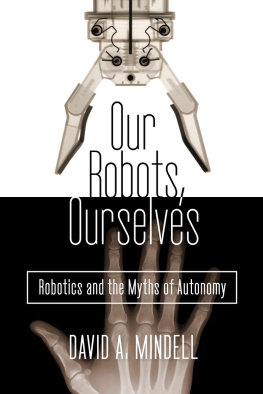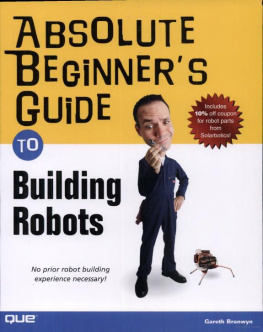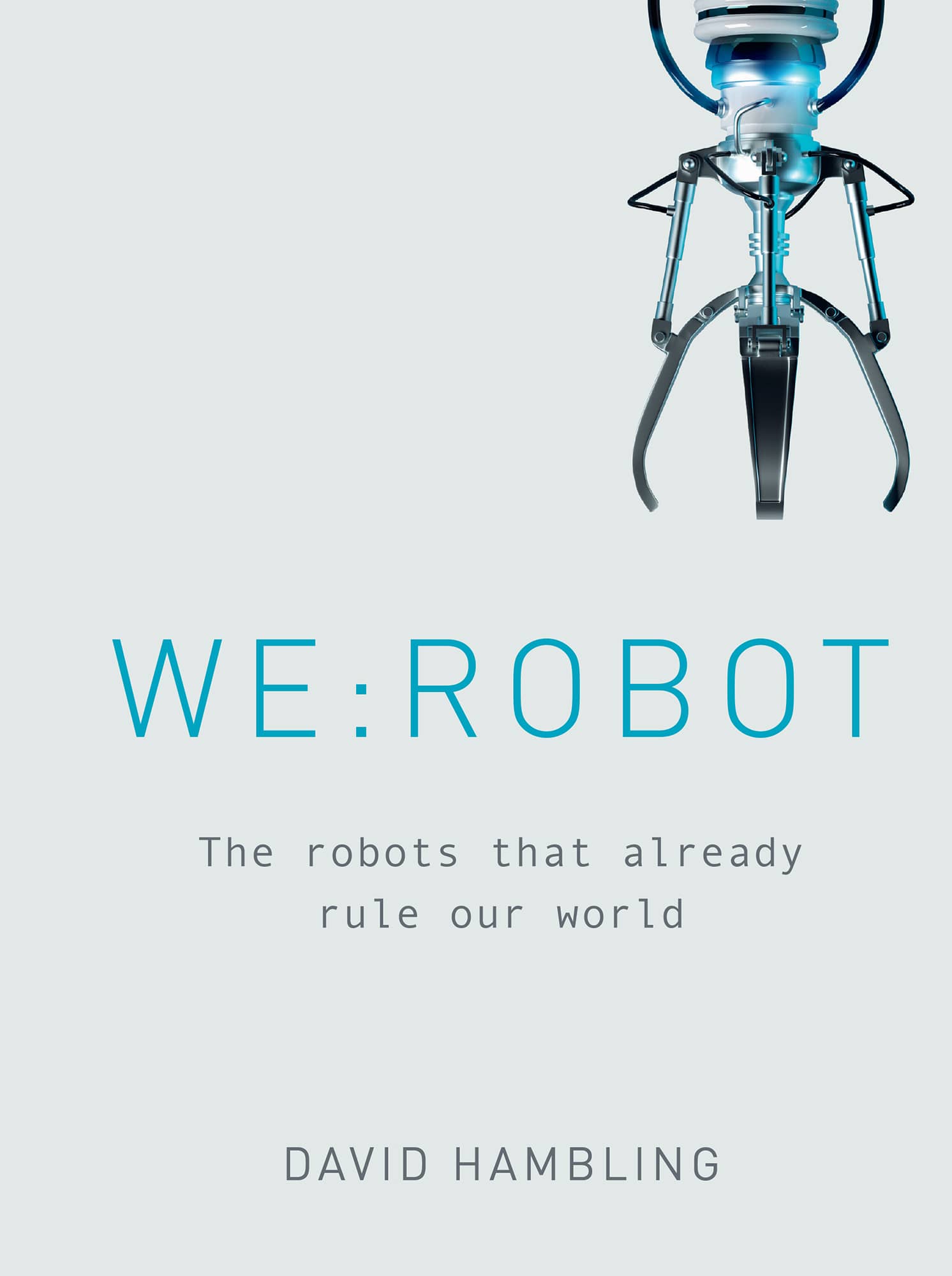WE : ROBOT
The robots that already rule our world
DAVID HAMBLING

INTRODUCTION
Robots are changing the world but before we can begin to talk about them, we need to decide what a robot is. What distinguishes a robot from any other machine? The stereotypical robot is a mechanical humanoid that walks and talks like a person, but robots like that only exist so far in science fiction. In the real world, most robots neither walk nor talk, and are nothing like people.
Going back to the words origin is little help. The term robot was first used in Karel Capeks 1921 play R.U.R. for which he created a race of artificial industrial workers Rossums Universal Robots the word robot is derived from a Czech word meaning forced labour. To make matters more confusing, Capeks fictional robots were organic beings that were grown synthetically, more like clones than our idea of robots.
The Oxford English Dictionary suggests that a robot is a machine capable of carrying out a complex series of actions automatically. This would include machines like dishwashers and washing machines, which are perhaps unfairly not seen as robots. The International Federation of Robotics defines a robot as an automatically controlled, reprogrammable, multipurpose manipulator which may be either fixed in place or mobile. This may be useful in the industrial field, but misses many others; surgical robots, for example, are not programmable.
Early ideas of robots came from fiction, and developers played up the mechanical man stereotype of literatures invention. Elektro the Moto Man was a metallic human 2m (6.5ft) tall, who gave demonstrations to packed houses at the 1939 New York Worlds Fair. He could respond to verbal commands, answer questions in a suitably robotic voice, count on his fingers and even smoke a cigarette. Elektro was built by the Westinghouse Electric Corporation to showcase some of its most advanced technology: photocells and electrical relays were cutting-edge industrial technology. Elektro was a fake, his answers pre-scripted and his abilities limited to set tricks, but robotic devices using the same technology were doing real work.
Machines that took over the jobs of humans were often called robots. The first traffic signals were installed outside the Houses of Parliament in 1868, with red, green and amber gas lights for the nights, based on signals that directed trains. A policeman operated them manually. When automated traffic lights were introduced, in the 1920s, they were known as robot policemen.
In the 1940s, Nazi Germany fielded the V-1, a pilotless aircraft carrying explosives. These were known in the English-speaking world as robot aircraft or just robots (doodlebug and buzz bomb were less common). We might now call them drones, a term that overlaps confusingly with robots.
For this book, we have accepted a broad definition of what makes a robot. Surgical and bomb-disposal machines that are universally known as robots are included, even though some might argue they are remote-controlled and not real robots. There are plenty of robot vehicles on the ground, on the water and in the air, as well as underwater and underground. There are also devices that require a human operator, that are unquestionably robotic in nature, such as prosthetic hands or complete exoskeletons. But, perhaps the robots that continue to fascinate us the most are the humanoids.
Serious efforts to build a human-like robot date back at least to designs sketched by Leonardo da Vinci for a mechanical knight in 1495, often cited as the ancestor of modern robots. Leonardo used his knowledge of human anatomy, the workings of joints and muscles to build an artificial human with levers and pulleys. The design, based on a suit of armour, could move its arms and legs and raise its visor. It even had a rudimentary form of programming, as it could be set to perform different actions by changing the settings of gears on a clocklike controller.
We do not know if Leonardos knight was ever built, but it shows a profound understanding of the issues of robotics, and how problems can be overcome by borrowing techniques from nature. Modern robot arms, with their wrist and elbow joints, bear more than a coincidental resemblance to Leonardos knight. Given the same challenge of articulation and moving a hand through three-dimensional space, engineers arrive at the same solution.
While robots may have been around for centuries, the current generation offer something entirely new. Now we are moving from the illusion of human capability to the reality. They may walk clumsily, and drive poorly, and lack human skill when it comes to picking up an apple, but robots are learning fast. The day is coming when they will rival and then surpass us in all sorts of fields. These robots are already starting to change the world. In the coming decades, they will do far more.
ROBOTS
AT WORK
ROBOTS AT WORK
Up until now, robots have tended to stay hidden away in factories, where they are the most efficient and reliable of workers. They have always been strong and fast, but they have also been half-blind and unable to make their way around on their own. Such factors limited their uses to a narrow range of tasks, but the situation is changing, and changing fast.
The first industrial robots were dangerous to be around and so were segregated from human workers. New industrial production-line machines such as FANUCs sensor-laden CR-35iA can work safely alongside people to combine the benefits of machine strength with human skill. A similar, but much smaller, robotic arm, Universal Robots UR-10 takes the idea even further, with its makers daring to boast that its machines can automate any task.
Agriculture has been largely mechanised for decades, but there is still one last mile to go before we can leave all the work to the machines. Cattle are rounded up by all-terrain vehicles (ATVs) rather than by horse, but the vehicle still needs a rider. Cows are milked by machine, but the machines need an operator. And some crops, such as fruit, still need to be picked by hand. Ingenious inventors are working on all of these: the Lely Astronaut is a robotic cow-milking system, SwagBot is a robot cowboy, while the Agrobot picks the softest and most delicate fruit quickly and carefully using robotic arms.
Though robots are good at dull and routine tasks, there are several jobs that, though unskilled, always seemed too tricky for a robot to master. But not anymore. Now a GEKKO Facade Robot can clean skyscraper windows and the Alpha burger-bot prepares gourmet hamburgers, assembling and bagging them ready to go. If you bought this book online, then it was probably handled by an Amazon Kiva robot somewhere along the way. Meanwhile, in the skies above us, our planes are getting a makeover: the PIBOT is preparing to take over from flesh-and-blood pilots if the passengers will accept it.
Not all jobs require hands or manipulators: many are just a question of inspection, and robots can get to places that are inaccessible to humans. The PureRoboticsTM Pipeline Inspection System can travel down the insides of pipes and check their condition remotely, like a suburban version of a Mars rover. Drones enable us to see landscapes in realtime for surveys, and Airobotics Optimus drone-in-a-box provides an automated system that can carry out detailed 3D surveys without human intervention.



